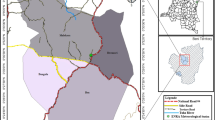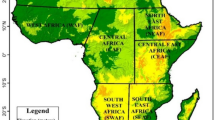Abstract
Measured air temperature and precipitation data from three high mountainous Bulgarian stations were used along with data from 18 global climate models (GCMs). Air temperature and precipitation outputs of preindustrial control experiment were compared with actually observed values. GCM with the best overall performance is BCCR BCM 2.0 for air temperatures (period 1941–2009) and CGCM 3.1/T47 for precipitation (period 1947–2009). Statistical methods were used in this research—nonparametric Spearman correlation, Mann–Whitney test, multiple linear regression, etc. Projections were made for the following future decades: 2015–2024, 2045–2054 and 2075–2084. The best months, described by multiple linear regression (MLR) model of air temperatures, are November, January, March, and May. The worst described are summer months. There is not any pattern in the relationship between constructed MLR models and measured precipitation. Models that perform the best in different months at the three investigated stations are MIUB ECHO-G, GISS AOM, CGCM 3.1/T63, and CNRM CM3 for air temperatures and GFDL CM 2.1, GISS AOM, and MIUB ECHO-G for precipitation. The fit between statistical models' outputs and values observed at stations is different, better in cold part of the year. There will be mixed future changes of air temperatures at all the three high mountainous stations. An increase of temperatures is expected in April, November, and December. A decrease will happen in February, July, and October. Mean annual temperatures are expected to rise by 0.1 °C (Botev) to 0.2 °C (Musala and Cherni vrah) in the decade 2075–2084, but mean annual temperatures at the end of the period with measurements (2009) has already exceeded by far projected values. Trends in precipitation are mixed both in spatial and in temporal directions. Observed decrease of precipitation, especially in the warm half of the year, is not described well in MLR models. The same is valid for annual amounts, which are projected to be higher than those measured in the end of instrumental period (2009). This is opposite to observed trends in recent decades, especially at stations Cherni vrah and Botev, where a significant decrease of precipitation amounts has happened.















Similar content being viewed by others
References
Alexandrov V (1997a) GCM climate change scenarios for Bulgaria. Bulg J Meteorol Hydrol 8(3–4):104–120
Alexandrov V (1997b) Vulnerability of agronomic systems in Bulgaria. Clim Chang 36(1–2):135–149. doi:10.1023/A:1005309911597
Alexandrov V (1999) Vulnerability and adaptation of agronomic systems in Bulgaria. Clim Res 12:161–173
Alexandrov V, Genev M (2003) Climate variability and change impact on water resources in Bulgaria. Eur Water 1(2):25–30
Alexandrov V, Hoogenboom G (2000) The impact of climate variability and change on crop yield in Bulgaria. Agr Forest Meteorol 104(4):315–327. doi:10.1016/S0168-1923(00)00166-0
Beniston M (2006) Mountain weather and climate: a general overview and a focus on climatic change in the Alps. In: Lami, Boggero A (eds) Hydrobiologia 562:3–16 A. Ecology of high altitude aquatic systems in the Alps. doi 10.1007/s10750-005-1802-0
Busuioc A, Giorgi F, Bi X, Ionita M (2006) Comparison of regional climate model and statistical downscaling simulations of different winter precipitation change scenarios over Romania. Theor Appl Climatol 86:101–123. doi:10.1007/s00704-005-0210-8
Chang CH, Knight G, Staneva MP, Kostov D (2002) Water resource impacts of climate change in southwestern Bulgaria. GeoJournal 57:159–168. doi:10.1023/B:GEJO.0000003611.11187.5c
Climate change (2007) IPCC fourth assessment report, http://www.ipcc.ch/
Hartig EK, Grozev O, Rosenzweig C (1997) Climate change, agriculture and wetlands in Eastern Europe: vulnerability, adaptation and policy. Clim Chang 36(1–2):107–121. doi:10.1023/A:1005304816660
Huth R (1999) Statistical downscaling in central Europe: evaluation of methods and potential predictors. Clim Res 13:91–101
Kettle H, Thompson R (2004) Statistical downscaling in European mountains: verification of reconstructed air temperature. Clim Res 26:97–112
Knight G, Raev I, Staneva MP (2004) Drought in Bulgaria: a contemporary analog for climate change. Ashgate studies in environmental policy and practice. ISBN 0 7546 4215 1
Labraga JC (2010) Statistical downscaling estimation of recent rainfall trends in the eastern slope of the Andes mountain range in Argentina. Theor Appl Climatol 99:287–302. doi:10.1007/s00704-009-0145-6
Meehl GA, Covey C, Delworth T, Latif M, McAvaney B, Mitchell JFB, Stouffer RJ, Taylor KE (2007) The WCRP CMIP3 multi-model dataset: a new era in climate change research. Bull Am Meteorol Soc 88:1383–1394
Schmidli J, Goodess CM, Frei C, Haylock MR, Hundecha Y, Ribalaygua J, Schmith T (2007) Statistical and dynamical downscaling of precipitation: an evaluation and comparison of scenarios for the European Alps. J Geophys Res 112:D04105. doi:10.1029/2005JD007026
Wilby RL, Charles SP, Zorita E, Timbal B, Whetton P, Mearns LO (2004) Guidelines for use of climate scenarios developed from statistical downscaling methods, technical report, Data Distrib. Cent., Intergovt. Panel on Clim. Change, Norwich, U. K
Wilks DS (2006) Statistical methods in the atmospheric sciences, Vol 91, 2nd edn. (International Geophysics). Elsevier
Acknowledgments
The author acknowledges the modeling groups, the Program for Climate Model Diagnosis and Intercomparison (PCMDI), and the WCRP's Working Group on Coupled Modelling (WGCM) for their roles in making available the WCRP CMIP3 multi-model dataset. Support of this dataset is provided by the Office of Science, U.S. Department of Energy.
Author information
Authors and Affiliations
Corresponding author
Rights and permissions
About this article
Cite this article
Nojarov, P. Bulgarian mountains air temperatures and precipitation—statistical downscaling of global climate models and some projections. Theor Appl Climatol 110, 631–644 (2012). https://doi.org/10.1007/s00704-012-0709-8
Received:
Accepted:
Published:
Issue Date:
DOI: https://doi.org/10.1007/s00704-012-0709-8




